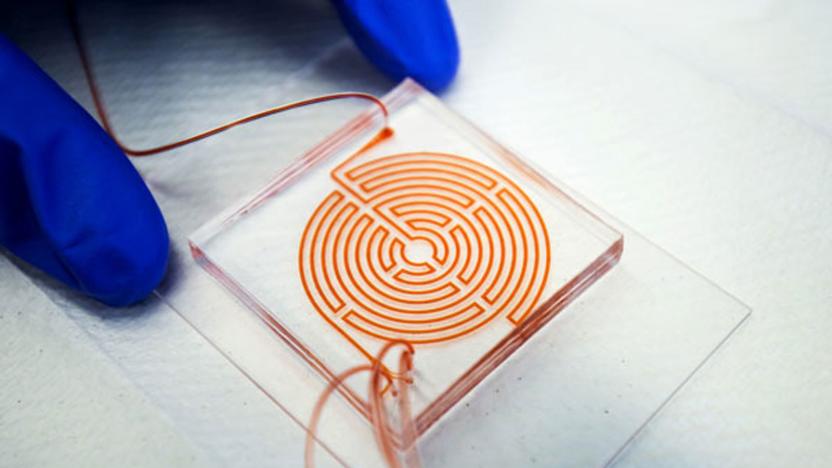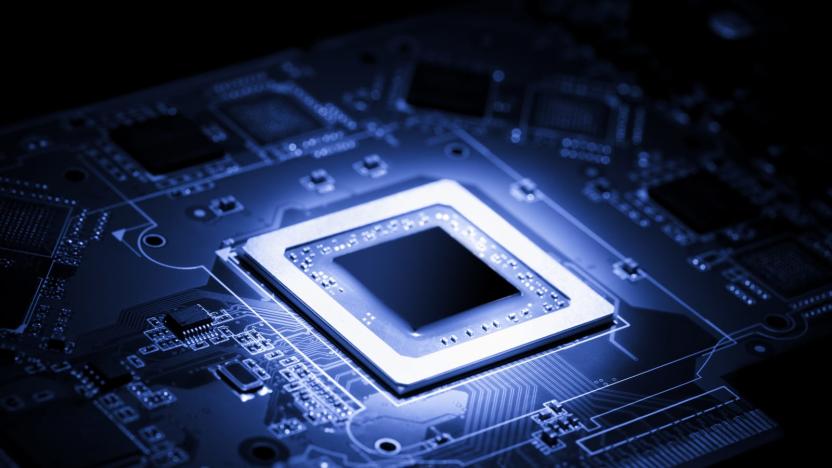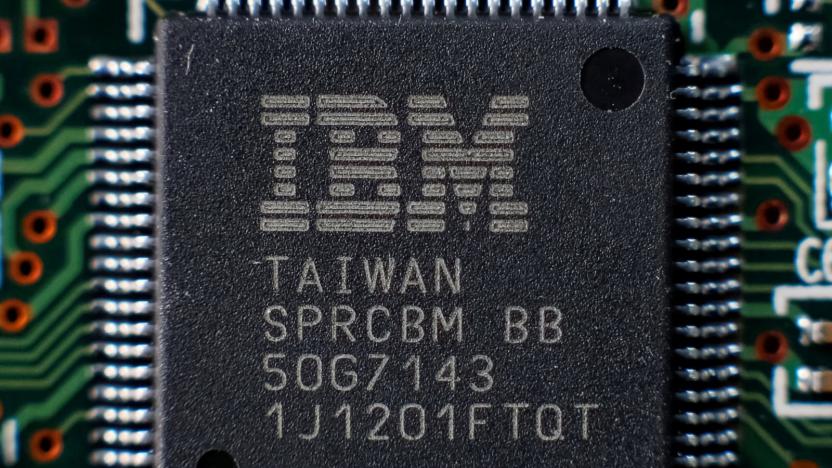chip
Latest

Samsung's 512GB chip will give your phone PC-like storage
Samsung has begun mass production of the world's first 512GB embedded Universal Flash Storage (eUFS), meaning its flagship phones can now hold double what they could last year, when the company released its 256GB version. Phones with the new chips can store up to 130 10-minute UHD videos.

What is Intel Coffee Lake?
Intel's 8th-generation "Coffee Lake" CPUs are now on the market. These chips come with a modest bump in CPU frequency, but the big news is that Intel is finally adding 6-core processors to its mainstream i7 and i5 lines. More cores means these chips will perform better at tasks that benefit from multithreading, such as content creation and data processing, and the increase in frequency and cores will give a boost to gaming frame rates. Intel used to release chips on a "tick-tock" cycle that saw every release alternate either a new design, or a new manufacturing process - called a "node." A new process node, like moving from 45nm to 22nm, means smaller transistors and a faster or more power-efficient chip. But manufacturing challenges made tick-tock falter a few years ago, and now new releases are much harder to predict. "Coffee Lake" is the fourth chip Intel has released at 14nm, and the third based on the "Skylake" design from 2015. New designs and nodes are coming, but we'll probably have to wait until they arrive in 2018 to see a big jump in performance.

Intel unveils an AI chip that mimics the human brain
Lots of tech companies including Apple, Google, Microsoft, NVIDIA and Intel itself have created chips for image recognition and other deep-learning chores. However, Intel is taking another tack as well with an experimental chip called "Loihi." Rather than relying on raw computing horsepower, it uses an old-school, as-yet-unproven type of "nueromorphic" tech that's modeled after the human brain.

Maze-like chip helps spot aggressive cancer cells
It's difficult to spot cancer cells -- just one in a billion blood cells are cancerous. How do you isolate them to know the trouble someone is facing and eventually treat it? By drawing the kind of mazes you enjoyed as a kid, apparently. Researchers have developed a microfluidic chip that uses a circular labyrinth to separate cancer cells from the rest of your bloodstream and spot the stem-like cells that will aggressively spread that cancer. Ultimately, it's a creative use of physics. The curves tend to push larger cancer cells forward (smaller regular cells cling to the walls), while the corners mix things up and put white blood cells in an ideal position.

CNBC: Tesla is working on its own AI chip with help from AMD (update: apparently not)
It's no secret that Tesla always wanted to develop an in-house chip to handle its cars' autonomous functions. Well, according to CNBC, the EV-maker is close to reaching that goal -- with help from AMD. The company is reportedly building its chip on top of AMD technology and is even working with AMD spin-off and chip fabricator GlobalFoundries to make its vision a reality. It also hired Jim Keller, who previously worked with AMD and Apple, to lead its chip division. In fact, they're far enough in the development process to be able to make samples of the processor's first implementation, and Tesla has already begun testing them.

Quantum 'hashtags' may prove the existence of a strange particle
Hashtags could soon be useful for a lot more than fostering discussion on your favorite social network. Researchers have developed a hashtag-shaped quantum chip (shown below) that could confirm the existence of the oddball Majorana particle, which exists as both matter and antimatter at the same time. The team has learned that laying indium phosphide nanowires in the familiar '#' shape creates a closed circuit that lets the particles pass by each other and braid, rather that annihilating each other like they would on a single wire. Think of it like creating streets with intersections instead of a one-lane road -- the 'traffic' can actually get around without collisions.

Samsung's high-capacity V-NAND memory is perfect for massive SSDs
Just over four years since it unveiled the first 3D vertical NAND memory, Samsung has developed its first 1 terabit (Tb) V-NAND chip. The flash memory technology, used in devices ranging from smartphones to digital cameras, will launch next year. As its name suggests, V-NAND boasts a vertically stacked structure with greater density than memory cells placed on a single, 2D plane. The result is more speed, up to ten times more reliability, and less chance of a breakdown. As with its 256 gigabit consumer SSDs, Samsung's new chips will probably find their way into your next laptop, and maybe even future phones. That's not all, Samsung also announced that the 1Tb chip will enable a single V-NAND package with 2 terabytes of memory capacity. As you might have guessed, that could mean more bang for your buck when it comes to SSDs for home PCs.

Samsung topples Intel as world’s largest chipmaker
Samsung registered a record profit of $12.6 billion in its second quarter earnings report, but hidden in those numbers lies another milestone. Of its $54 billion in revenue, $15 billion came solely from Samsung Semiconductors -- pushing it above the $14.8 billion that all of Intel brought in. In short: Samsung just ended Intel's 24-year-reign and became the largest chipmaker in the world.

Wisconsin company offers staff implants for keys and passwords
Don't assume that companies chipping employees is usually the stuff of dystopian science fiction -- it's here... although it's better than it sounds. Wisconsin's Three Square Market is giving employees the option of receiving a rice-sized implant (not pictured above) that will handle authentication for just about everything at work. It's the first such company-wide move in the US, Three Square claims. The chip will handle payments for food in the break room, front door access and even PC sign-ins. It promises to be very convenient, but it's easy to see why people would balk at an idea that sounds Orwellian at first blush. Three Square at least appears to be addressing some of those issues, but there are still some problems that are difficult to escape.

Ever-changing memory could lead to faster processors
Virtually every central processor in your devices uses a tiered set of memory caches to speed things up by fetching commonly used data. But it's not very efficient -- in trying to accommodate everything, it's rarely the fastest at anything. MIT's CSAIL researchers want to fix that. They've developed a cache system (appropriately named Jenga) that creates new cache structures on the spot to optimize for a specific app. As Jenga knows the physical locations of each memory bank, it can calculate how to store data to reduce the travel time (and thus lag) as much as possible, even if that means changing the hierarchy. Whether an app would benefit from multiple cache levels or one gigantic cache, this system would be ready.

Qualcomm's new fingerprint sensors work underwater
Hot on the heels of Apple's plans to reinvent its iPhone's fingerprint reader, Qualcomm looks set to position itself at the forefront of the fingerprint sensor market. It claims that it will be one of the first, if not the first, companies to produce under-display sensors. Unveiling its plans at Mobile World Congress Shanghai, the company revealed that its next-gen fingerprint sensors will use ultrasonic technology that can be fitted under displays, glass and metal, and can scan through OLED displays up to 1200um -- something we got to see in action for ourselves at Vivo's booth.

American military backs an entirely new kind of processor
Virtually every processor you see is based on the same basic (Von Neumann) computing model: they're designed to access large chunks of sequential data and fill their caches as often as possible. This isn't the quickest way to accomplish every task, however, and the American military wants to explore an entirely different kind of chip. DARPA is spending $80 million to fund the development of the world's first graph analytic processor. The HIVE (Hierarchical Identify Verify Exploit) accesses random, 8-byte data points from the system's global memory, crunching each of those points individually. That's a much faster approach for handling large data, which frequently involves many relationships between info sets. It's also extremely scalable, so you can use as many HIVE chips as you need to accomplish your goals.

IBM squeezes 30 billion transistors into a fingernail-sized chip
Who said Moore's Law was dead? Certainly not IBM or its chip partners Globalfoundries and Samsung. The trio has developed a transistor manufacturing process that should pave the way for 5-nanometer chips. While the team etched the chip using the same extreme ultraviolet lithography (EUV) used for the breakthrough 7nm chip, it ditched the common FinFET (fin field effect) transistor design in favor of stacks of silicon nanosheets. The switch makes it possible to fine-tune individual circuits to maximize their performance as they're crammed into an incredibly small space. How small? At 5nm, the group says it can squeeze 30 billion transistors into a chip the size of a fingernail (see below) -- not bad when the 7nm chip held 20 billion transistors a couple of years ago.

Mastercard aims to speed up your chip-and-PIN payments
Chip cards are ultimately faster than paying with a magnetic stripe and a signature (or worse, a check), but they're sometimes slow -- and it's bad enough that Mastercard wants to do something. The company is partnering with Verifone and Global Payments to build its speedy M/Chip Fast technology into EMV card reading systems destined for the US. The focus is on fast food, grocery stores, mass transit and anywhere else that waiting even a few seconds might cause frustration (especially for the people behind you).

Qualcomm's new mid-tier mobile chips are good news for gaming
Qualcomm's latest mid-tier mobile chipsets, the Snapdragon 630 and 660, are designed to give smartphone users more processing power, crisper photos and improved connection speeds over LTE or WiFi, among a few other fresh features. The 630 upgrades the 625 processor, while the 660 follows the 653.

Self-assembling wires could lead to faster processors
There's a very real fear that processor speed upgrades will slow to a crawl as it becomes increasingly difficult to make denser chips. Don't tell that to a team of researchers at MIT and in Chicago, though -- they've devised a chip-making technique that could keep Moore's Law relevant for a while longer. Their approach produces much finer wires by letting them partly assemble themselves, rather than relying on the very deliberate (not to mention slow) ultraviolet or scanning processes used to make chips today.

How an animated-GIF camera morphed into a nascent chip empire
Not many computers can thank GIFs for their existence. In 2013, Dave Rauchwerk worked on a San Francisco art installation that allowed people to record and project a GIF of themselves onto a building. It was popular and led to Rauchwerk joining with two friends to start a hardware company called Next Thing Co. Their aim? To create a camera that can capture GIFs for $100. After a long stay in China with the HAX Accelerator, Next Thing Co. launched OTTO, a $250 "hackable GIF camera" in 2014. It was the first product to integrate Raspberry Pi's Compute Module, and generated a lot of interest. Keen mathematicians may have noted the discrepancy in the intended and actual price -- $250 is many more dollars than $100 -- and the public did, too.

Apple sues Qualcomm for $1 billion in royalty dispute
Apple has filed a $1 billion lawsuit against Qualcomm, claiming that for many years, the chip manufacturer has "unfairly insisted on charging royalties for technologies they have nothing to do with," CNBC reports. This marks the end of a rough week for Qualcomm: The Federal Trade Commission on Tuesday sued the company for its alleged use of monopolistic and exclusionary tactics within the baseband processor market. Apple's lawsuit piggybacks off of these claims. For reference, baseband processors are the chips that power network connectivity in mobile devices.

TSMC plans a new factory to pump out tomorrow's 3 nm chips
News leaked in late August that chipmaker Taiwan Semiconductor Manufacturing Co (TSMC) and Apple were working shrinking the A11 processor set to go in next year's iPhone down to 10nm. But to ensure it stays in business with the tech titan and other device manufacturers, TSMC is planning to build a new plant to build future chips at 5nm and 3nm sizes.

HoloLens' 24-core chip makes vivid AR possible
Microsoft has revealed more details about its HoloLens headset at the Hot Chips conference in Cupertino. The augmented reality (AR) device marries video games with the real world, so it needs to calculate your location, head position and gestures extremely rapidly. We now know more about the so-called holographic processing unit (HPU) that does that -- the 24-core chip has near-supercomputer levels of performance, performing a trillion operations per second.







